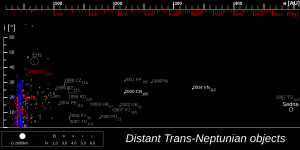
Back جرم منفصل Arabic Odvojeni objekt BS Objecte separat Catalan Oddělený disk Czech Detached Object German Objeto separado (transneptuniano) Spanish Banandutako objektu Basque Objet détaché French Obxecto separado Galician Odvojeni objekt Croatian

Cubewanos (classical KBO)
Scattered disc object
Detached object
Detached objects are a dynamical class of minor planets in the outer reaches of the Solar System and belong to the broader family of trans-Neptunian objects (TNOs). These objects have orbits whose points of closest approach to the Sun (perihelion) are sufficiently distant from the gravitational influence of Neptune that they are only moderately affected by Neptune and the other known planets: This makes them appear to be "detached" from the rest of the Solar System, except for their attraction to the Sun.[1][2]
In this way, detached objects differ substantially from most other known TNOs, which form a loosely defined set of populations that have been perturbed to varying degrees onto their current orbit by gravitational encounters with the giant planets, predominantly Neptune. Detached objects have larger perihelia than these other TNO populations, including the objects in orbital resonance with Neptune, such as Pluto, the classical Kuiper belt objects in non-resonant orbits such as Makemake, and the scattered disk objects like Eris.
Detached objects have also been referred to in the scientific literature as extended scattered disc objects (E-SDO),[3] distant detached objects (DDO),[4] or scattered–extended, as in the formal classification by the Deep Ecliptic Survey.[5] This reflects the dynamical gradation that can exist between the orbital parameters of the scattered disk and the detached population.
At least nine such bodies have been securely identified,[6] of which the largest, most distant, and best known is Sedna. Those with large semi-major axes and high perihelion orbits similar to that of Sedna are termed sednoids. As of 2024, there are three known sednoids: Sedna, 2012 VP113, and Leleākūhonua.[7] These objects exhibit a highly statistically significant asymmetry between the distributions of object pairs with small ascending and descending nodal distances that might be indicative of a response to external perturbations; asymmetries such as this one are sometimes attributed to perturbations induced by unseen planets.[8][9]
- ^ Lykawka, P.S.; Mukai, T. (2008). "An outer planet beyond Pluto and the origin of the trans-Neptunian belt architecture". Astronomical Journal. 135 (4): 1161–1200. arXiv:0712.2198. Bibcode:2008AJ....135.1161L. doi:10.1088/0004-6256/135/4/1161. S2CID 118414447.
- ^ Jewitt, D.; Delsanti, A. (2006). "The Solar System Beyond the Planets". Solar System Update: Topical and Timely Reviews in Solar System Sciences (PDF) (Springer-Praxis ed.). Springer. ISBN 3-540-26056-0. Archived from the original (PDF) on 29 January 2007.
- ^ Gladman, B.; et al. (2002). "Evidence for an extended scattered disk". Icarus. 157 (2): 269–279. arXiv:astro-ph/0103435. Bibcode:2002Icar..157..269G. doi:10.1006/icar.2002.6860. S2CID 16465390.
- ^ Gomes, Rodney S.; Matese, J.; Lissauer, Jack (2006). "A distant planetary-mass solar companion may have produced distant detached objects". Icarus. 184 (2). Elsevier: 589–601. Bibcode:2006Icar..184..589G. doi:10.1016/j.icarus.2006.05.026.
- ^ Elliot, J.L.; Kern, S.D.; Clancy, K.B.; Gulbis, A.A.S.; Millis, R.L.; Buie, M.W.; Wasserman, L.H.; Chiang, E.I.; Jordan, A.B.; Trilling, D.E.; Meech, K.J. (2006). "The Deep Ecliptic Survey: A search for Kuiper belt objects and centaurs. II. Dynamical classification, the Kuiper belt plane, and the core population" (PDF). The Astronomical Journal. 129 (2): 1117–1162. Bibcode:2005AJ....129.1117E. doi:10.1086/427395.
- ^ Lykawka, Patryk Sofia; Mukai, Tadashi (July 2007). "Dynamical classification of trans-neptunian objects: Probing their origin, evolution, and interrelation". Icarus. 189 (1): 213–232. Bibcode:2007Icar..189..213L. doi:10.1016/j.icarus.2007.01.001.
- ^ Huang 黄, Yukun 宇坤; Gladman, Brett (2024-02-01). "Primordial Orbital Alignment of Sednoids". The Astrophysical Journal Letters. 962 (2): L33. arXiv:2310.20614. Bibcode:2024ApJ...962L..33H. doi:10.3847/2041-8213/ad2686. ISSN 2041-8205.
- ^ de la Fuente Marcos, Carlos; de la Fuente Marcos, Raúl (1 September 2021). "Peculiar orbits and asymmetries in extreme trans-Neptunian space". Monthly Notices of the Royal Astronomical Society. 506 (1): 633–649. arXiv:2106.08369. Bibcode:2021MNRAS.506..633D. doi:10.1093/mnras/stab1756.
- ^ de la Fuente Marcos, Carlos; de la Fuente Marcos, Raúl (1 May 2022). "Twisted extreme trans-Neptunian orbital parameter space: statistically significant asymmetries confirmed". Monthly Notices of the Royal Astronomical Society Letters. 512 (1): L6 – L10. arXiv:2202.01693. Bibcode:2022MNRAS.512L...6D. doi:10.1093/mnrasl/slac012.